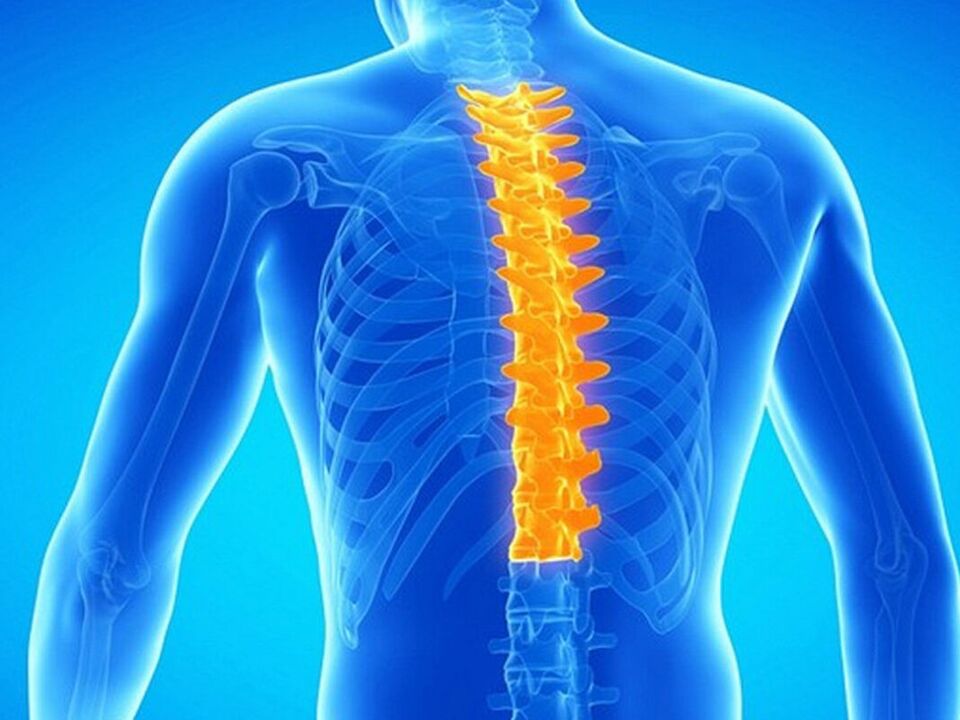
An inactive lifestyle, injuries or excessive physical activity cause diseases of the musculoskeletal system. To avoid complications, it is important to start treatment early in the process. To do this, you need to know about the causes and symptoms of pathology.
Description of this disease, what is the danger
Osteochondrosis of the thoracic spine is a chronic disease in which dystrophic changes begin in the cartilage located in the intervertebral space. Pathology is expressed by a decrease in disc height and compression of the intercostal nerve endings.
Thoracic osteochondrosis goes through several stages of development.
The first is characterized by the drying of the intervertebral disc, a decrease in firmness and elasticity, and the appearance of cracks. The pain is mild and goes away after the person gets some rest.
In the second stage, the disc decreases in height, the recess in the vertebra is filled with the nucleus pulposus, but it does not go beyond its borders. Muscles are under constant tension. Someone complains of severe pain, which subsides after rest.
The third stage is characterized by the exit of the nucleus pulposus outside the edge, the crack reaches the edge of the vertebra. As a result, an intervertebral hernia is formed. The pain becomes constant.
In the fourth stage, excessive growth of connective tissue is found, which puts pressure on nearby vertebrae. To compensate for the reduced layer, the growth of bone tissue begins. More and more growths (osteophytes) appear.
Types of thoracic osteochondrosis and complications
According to the nature of the pain, there are two types of thoracic osteochondrosis:
- dorsago, which is characterized by acute sharp pain in the form of lumbago, localized in the thoracic spine. This condition is accompanied by muscle tension, problems with movement in the neck and thoracic region;
- dorsalgia, where the pain increases slowly. Inhalation and turning of the body, as well as staying in one position for a long time, increase the discomfort. At night, the discomfort deepens, and disappears when climbing.
In the absence of adequate therapy, nerve endings are increasingly compressed. As a result, osteochondrosis of the thoracic spine can cause complications:
- kidney pathology;
- diseases of the digestive system;
- immobility;
- persistent pain;
- disturbances in cardiac activity;
- intervertebral hernia;
- decreased ability to conceive;
- violation in the work of the lungs, which is caused by the growth of connective tissue.
Why does thoracic spine pathology occur?
This part of the spine experiences moderate loads and limited mobility. However, pathology is common. This disease can be provoked by one of the reasons or their combination:
- injury and damage;
- excessive burden on the department, including in childhood;
- age-related changes associated with a decrease in nutrition of intervertebral disc tissue;
- endocrinological profile diseases, especially during menopause;
- age-related calcium absorption disorders;
- overweight;
- problems with blood vessels, atherosclerotic deposits in the vessels of the thoracic region;
- weak muscle corset.
How pathology manifests itself
Symptoms of thoracic osteochondrosis are represented by pain and increased muscle tone. Pain can be both short-term with lumbago, and long-term pain. Recoil can be felt in the anterior chest, under the ribs, and in the shoulders. The pain worsens with prolonged stay in one position.
A characteristic sign of pathology is sensitivity to palpation of the spinous process of the thoracic vertebrae.
Symptoms of osteochondrosis of the thoracic spine are similar to other diseases and include:
- discomfort in the heart area, reminiscent of angina pectoris pain;
- pain when breathing, shortness of breath, also shown in pneumonia, dry cough, obstructive pulmonary disease;
- pain in the epigastric region, under the ribs, similar to signs of gastrointestinal disease.
Methods of treatment of thoracic osteochondrosis
If you complain, you need to contact a neurologist. Therapy includes medication, physiotherapy, exercise therapy and massage.
Of the medicines, the doctor prescribes:
- ways to eliminate the focus of inflammation in the spine;
- drugs to reduce muscle tone and the risk of squeezing the sensitive roots of the spinal cord;
- neuroprotectors are designed to help restore nerve fibers.
The choice and dosage is chosen by the doctor, who will take into account drug tolerance, comorbidities and the patient's weight.
It is important to observe the recommended treatment period to avoid recurrence. You can buy prescribed drugs cheaply in online stores. Information about prices, drugs in stock, current promotions and discounts is available around the clock on the site.
You can order medicine now, customers are offered delivery and self-delivery options.
Physiotherapy includes:
- diadynamic therapy, that is, electric current treatment to relax muscles and reduce pain;
- electrophoresis with painkillers;
- magnetic therapy to relieve discomfort and swelling.
Massage should be done carefully, using a rubbing technique. The area below the shoulder blades and between the ribs should be carefully treated. For the appearance of the effect, at least 10-15 sessions are required.
During physiotherapy training, emphasis is placed on exercises that strengthen the muscular corset, neck and lower back.
Locally prescribed ointments and gels with anti-inflammatory action, heating patches, needle applicators.






















